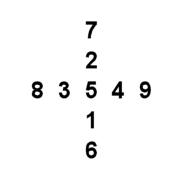
on a Komodo Dragon
It is said in a legend that Fu Xi received a gift from heaven when he saw a Qi Lin (dragon horse) coming out of the Yellow River which had a unique and highly symetrical pattern of black and white dots on it's back. This pattern came to be known as the He Tu or River Chart.
The He Tu shows how the different types of qi originate from yin and yang:

- 1-6 1 Heaven generates water, Earth 6 completes it.
The North (bottom) is assigned the Water element. - 2-7 2 Earth generates fire, Heaven 7 completes it.
The South (top) is assigned the Fire element. - 3-8 3 Heaven generates wood, Earth 8 completes it.
The East (left) is assigned the Wood element. - 4-9 4 Earth generates metal, Earth 9 completes it.
The West (right) is assigned the Metal element. - 5-10 5 Heaven generates water, Earth 6 completes it.
The North (bottom) is assigned the Water element.

One example of the perfect symmetry of The He Tu is that the totals of the yang (odd) numbers and the yin (even) numbers are each equal to 20.
Counting the dots while disregarding the central five white and surrounding 10 black dots, all of the yang (odd) numbers are perfectly balanced by an opposing yin (even) number directly across from it. This corresponds to the theory that everything possesses a positive male bright side (Yang) but at the same time has a negative female dark side (Yin). These aspects are complementary and integrate with each other, and it is believed that harmony can only be achieved with a balance between the two.

